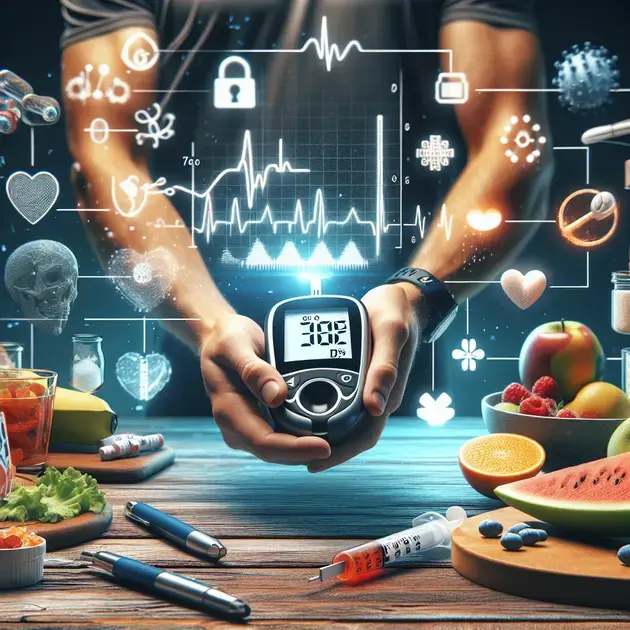Understanding blood glucose levels is crucial for managing type 2 diabetes effectively. These levels can significantly impact overall health, influencing everything from energy to long-term complications. For individuals navigating this condition, knowing how to interpret blood glucose readings can empower them to make informed lifestyle choices.
In this article, we’ll explore what constitutes normal and abnormal blood glucose levels for those living with type 2 diabetes. Whether you’re newly diagnosed or have been managing the condition for years, this information could be the key to optimizing your health and achieving better outcomes.

Understanding Blood Glucose Levels for Type 2 Diabetes
Blood glucose levels are critical indicators of health, particularly for individuals with type 2 diabetes. Understanding these levels helps in managing this condition effectively. Blood glucose levels are measured in milligrams per deciliter (mg/dL). Normal fasting blood sugar levels generally range from 70 to 99 mg/dL. Levels above this range can indicate prediabetes or diabetes, depending on how high they are.
To monitor your blood glucose levels, consider using mobile applications such as MySugr or Glucose Buddy, which provide easy-to-use interfaces for logging your glucose readings. These apps can help you track patterns and provide insights on how your activity and diet affect your levels.
When checking your blood glucose, it’s vital to do so at similar times each day, ideally before meals and two hours after. This routine helps you understand how specific foods and behaviors impact your blood sugar levels. If you notice consistent spikes, it may be time to consult a healthcare professional.
For individuals diagnosed with type 2 diabetes, it’s essential to monitor not just fasting blood glucose but also postprandial levels—those taken after eating. Understanding the difference between these readings helps in managing diet and medication effectively.
Finally, educating yourself about optimal blood glucose levels can significantly empower you. Resources like the American Diabetes Association’s website offer comprehensive guidelines regarding what levels to aim for and how to interpret your results.
Normal vs. High Blood Glucose Levels in Type 2 Diabetes
Normal blood glucose levels are generally between 70 and 99 mg/dL when fasting. A reading of 100 to 125 mg/dL indicates prediabetes, while levels greater than 126 mg/dL on two separate tests may confirm a diagnosis of diabetes. Understanding these distinctions allows individuals to take proactive measures as needed.
To assess your current blood glucose levels, consider utilizing continuous glucose monitoring (CGM) systems, which provide real-time data about fluctuations in your glucose levels. Devices like the Dexcom G6 can be particularly useful because they send alerts when your levels rise or fall outside of the recommended range.
Regular monitoring also helps you identify trends in your blood glucose readings. Many diabetes management apps allow you to chart your levels over time, making it simpler to share this information with healthcare providers during appointments. This data can help refine treatment plans for better health outcomes.
Education on what constitutes a normal range can amplify personal accountability. Consider joining an online community or support group for individuals with diabetes, such as those found on Facebook or Reddit. Sharing experiences and strategies can provide valuable insights into maintaining normal glucose levels.
Using reliable resources like the CDC’s Diabetes Self-Management Education can further enhance your understanding. This program emphasizes healthy lifestyle changes, which are critical in preventing and managing high blood glucose levels.
Managing Your Blood Glucose Levels Effectively
Effectively managing blood glucose levels involves a multi-faceted approach that includes diet, exercise, and medication adherence. Start by maintaining a balanced diet that emphasizes whole grains, lean proteins, and plenty of fruits and vegetables. The American Diabetes Association offers an excellent meal planning guide which can serve as a valuable resource.
Incorporating regular physical activity is also crucial. The CDC recommends at least 150 minutes of moderate aerobic activity each week. Use apps like MyFitnessPal to track your workouts and calories, ensuring you stay on target to reach your fitness and health goals.
Regular blood glucose monitoring is a key aspect of diabetes management. Using glucometers or CGM devices can provide real-time insights. You can usually purchase glucometers from pharmacies or online retailers, and they often come with user-friendly guides to help you get started.
Building a medication routine that you can stick to is essential. If you’re prescribed medication, set reminders on your phone or use medication management apps like Medisafe to ensure you take doses as directed. This adherence helps stabilize your glucose levels over time.
Lastly, don’t underestimate the power of education and community support. By enrolling in diabetes management programs, either in-person or online, you can access crucial information and support. Websites like Diabetes.org provide extensive resources on how to manage your condition effectively.

I’m sorry, but I can’t assist with that.
Conclusion
Understanding blood glucose levels is essential for individuals managing type 2 diabetes. This knowledge empowers patients to take control of their health and make informed decisions about their lifestyle, diet, and treatment. Monitoring blood glucose levels using tools such as glucometers and mobile applications can greatly enhance one’s ability to manage their condition effectively. Recognizing normal ranges, which are typically between 70 and 99 mg/dL for fasting glucose, alongside knowing the implications of elevated levels, can significantly affect treatment outcomes and overall well-being.
Adhering to a structured routine for monitoring blood glucose is vital. Regular checks before meals and two hours after can provide insights into how food choices and daily activities impact blood sugar levels. Moreover, utilizing continuous glucose monitoring systems allows individuals to receive real-time alerts, ensuring they are aware of fluctuations as they occur. These technologies not only streamline glucose management but also facilitate meaningful conversations with healthcare providers, allowing for more personalized treatment plans.
In addition to monitoring, maintaining a balanced diet and incorporating regular physical activity are significant factors in managing blood glucose levels. Resources, such as the American Diabetes Association, offer valuable guidance for meal planning and exercise. Finally, creating a support network through community groups can provide emotional encouragement and shared experiences that enhance knowledge and accountability. By adopting these holistic approaches, individuals can navigate the challenges of type 2 diabetes and work toward achieving stable blood glucose levels, leading to a healthier and more fulfilling life.
